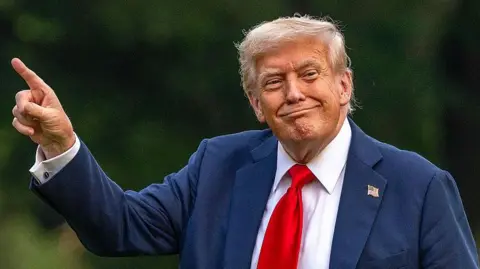### Overview of the US-Japan Trade Agreement
In a significant development for global trade, US President Donald Trump has hailed a recent trade agreement with Japan as potentially the “largest trade deal in history.” While such a proclamation may be viewed as ambitious, experts recognize this deal as a critical moment in trade relations, particularly following the tumultuous months marked by Trump’s “Liberation Day” tariffs announced in April, which had caused considerable uncertainty in the stock markets and global trading systems.
Following extensive negotiations between the two countries, Japan’s Prime Minister Shigeru Ishiba expressed optimism that the agreement would bolster the global economy. This declaration raises questions about the deal’s actual impact on international trade and economic growth in both nations and the broader Asian region.
### Implications for Japan’s Economy
Japan, known as the world’s fourth-largest economy, plays a substantial role in the global trade landscape. With a heavy reliance on imports for energy and food, Japan also exports significant quantities of electronics, machinery, and vehicles. The United States stands out as Japan’s largest export market, making this agreement particularly crucial.
There had been concerns among some economists that the tariffs imposed by Trump could reduce Japan’s GDP by as much as one percentage point, potentially leading the nation into a recession. However, the new agreement promises lower tariffs for Japanese exporters, facilitating easier access to the American market. The business environment created by the deal allows for better planning and stability for companies operating within Japan’s export-focused economy. Furthermore, the deal has positively influenced the value of the Japanese yen against the US dollar, granting Japanese manufacturers greater purchasing power for necessary raw materials.
### Benefits for the Automotive Sector
A notable aspect of the trade agreement is its favorable terms for Japan’s automotive industry, including leading companies such as Toyota, Honda, and Nissan. Previously, American importers faced a significant tariff of 27.5% on Japanese automobiles. This is now set to decrease to 15%, making Japanese cars more competitive against those produced in rival countries like China. However, some US automakers have raised concerns about the deal. They argue that they are at a disadvantage with a 25% tariff on vehicles produced in their North American plants, compared to Japan’s reduced tariff rate.
### Investment and Job Creation
As a counterbalance to the reduced tariffs, Japan has pledged to invest approximately $550 billion into the United States. This investment aims to enable Japanese companies to establish resilient supply chains in critical sectors such as pharmaceuticals and semiconductors, with the expectation of creating jobs and fostering innovation across the board. The agreement also entails that Japan will increase its imports of agricultural products, notably US rice, which could alleviate domestic shortages in Japan while raising concerns among local farmers about potential shifts in market dynamics.
### Regional Trade Dynamics and Competitive Pressures
South Korea, which has active trade discussions with the US, has shown interest in the specifics of the agreement between Japan and the US. Since both nations compete in sectors like automotive and steel, South Korea may feel pressure to negotiate better terms in its own trade discussions. This new agreement could force other countries, particularly those in Asia with significant export activities, to seek enhanced trade agreements with the US before an impending deadline of August 1. Countries like Indonesia and the Philippines have already made strides in this direction.
Conversely, smaller nations such as Cambodia, Laos, and Sri Lanka—primarily manufacturing exporters—may suffer from this competitive trade landscape, particularly as they possess limited leverage in negotiations with the US.
### Strategic Military and Trade Objectives
Although there were initial indications that the US aimed for Japan to increase its military expenditure as part of the trade deal, representatives have clarified that defense spending was not included in the agreement. The substantial tariffs on steel and aluminum remain unchanged, creating a scenario in which Japan, which primarily exports vehicles rather than metals, may see these conditions as favorable to its economy.
Moreover, the urgency for the US to finalize various trade agreements before the August deadline is palpable. In tandem with its negotiations with Japan, the US could explore partnerships with other nations to secure more stable trade relations. Interestingly, on the same day the trade deal was announced, Japan and the European Union expressed intentions to collaborate against economic coercion and unfair trade practices, potentially reshaping the trade landscape between major global economies.
### Conclusion
The recent US-Japan trade agreement signifies a pivotal moment in international trade, especially for Asian economies. As countries assess the implications of this development, the outcome will reveal how these trade relations evolve in a rapidly changing economic environment. The commitments made by Japan to invest in the US and the adjustments in tariffs could foster economic growth and recalibrate competitive dynamics in the region, with varying impacts on different nations depending on their trade profiles and currencies.












